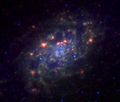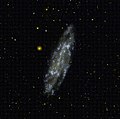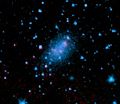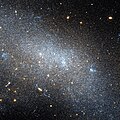| M81 Group | |
|---|---|
 | |
| Observation data (Epoch J2000) | |
| Constellation(s) | Ursa Major/Camelopardalis |
| Brightest member | M81 [1] (pictured) |
| Number of galaxies | 34 [1] |
| Other designations | |
| NGC 3031 Group | |
The M81 Group is a galaxy group in the constellations Ursa Major and Camelopardalis that includes the galaxies Messier 81 and Messier 82, as well as several other galaxies with high apparent brightnesses. [1] The approximate center of the group is located at a distance of 3.6 Mpc, making it one of the nearest groups to the Local Group. [1] The group is estimated to have a total mass of (1.03 ± 0.17)×1012 M☉. [2] The M81 Group, the Local Group, and other nearby groups all lie within the Virgo Supercluster (i.e. the Local Supercluster). [3]























